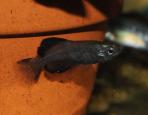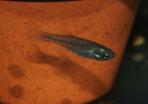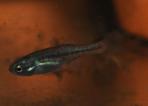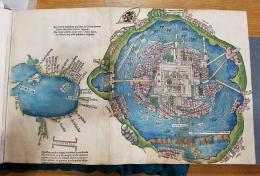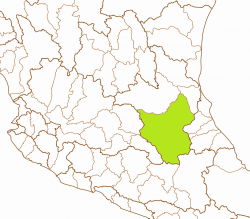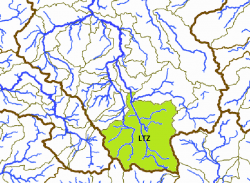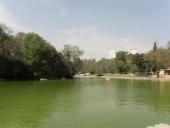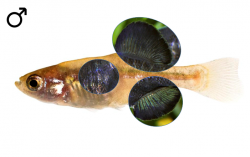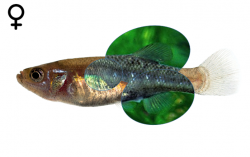Girardinichthys viviparus
The describer, with full name Miguel Francisco José María Nepomuceno Ignacio Praxedis Bustamante Septién, who was member of a famous Mexican family dedicated to science and humanism, was very interested in the phenomenon of this fish giving birth to live fish, but didn't deposit any Holotype.
The left picture shows Regans drawing of a female Girardinichthys viviparus, the right one Hernán Cortéz' famous map of the Aztec captital Tenochtitlán, surrounded by the large Texcoco lake, habitat of the Mexclapique:
The author didn't give an explicit Terra typica, but he mentioned this species being very abundant all over the city of México, and it was at all times to find on places and markets, where it was sold for food, mainly for the poor.
The species name is derived from the Latin. The word "vivus" means "alive" while "parus", with the meaning "bearing" has its origin in the verb "parire", "giving birth". So the whole epithet simply means "livebearing". Girardinichthys viviparus was the first species of Cyprinodontiformes where livebearing had been observed, and it inspired Bustamante to name this fish after this unusual phenomenon.
Pieter Bleeker erected this genus 1860 to honour the French biologist Charles Frédéric Girard. As Bleeker did many of his publications in Latin, he latinized Girard into Girardinus, and with the second part of the name, ἰχθύς (íchthús, íchthýs), the Greek word for fish, the generic name can be translated with "Girards fish".
Cyprinus viviparus Bustamante, 1837
Lucania (sp.) Girard, 1859
Girardinichthys innominatus Bleeker, 1860
Limnurgus variegatus Günther, 1866
Mollienesia (sp.) Gill, 1882
Lucania richi Goode, 1891
Characodon geddesi Regan, 1904
Limnurgus innominatus Regan, 1907
The Chapultepec Splitfin is endemic to the Mexican federal states Distrito Federal and México and is the only Goodeid species native to Mexico City. In the ancient times of Tenochtitlán, the capital of the Aztec empire, it must have had occupied the complete extension of the large Lago de Texcoco and its connected waterbodies in the endorheic valley of México, which included the lagos de Xochimilco, Xaltocán and Chalco and the Laguna Zumpango. Miguel Bustamante y Septién (1837) mentioned that this species was an exceedingly common fish in the lagoons and irrigation channels of Mexico City. Nowadays, after hundreds of years of draining wetlands and lakes to allow for the enormous expansion of Mexico City, Girardinichthys viviparus can just be found in the remnants of the former huge lakes. It has persisted only in the three artificial lakes in the Parque de Chapultepec inside Mexico City, with a stronghold in the Lago Mayor, with small numbers in the lakes Zumpango and Xochimilco, and in moderate numbers near the airport at Alameda Oriente, which belongs to the former Lake of Texcoco. Through the artificial Canal Río Cuautitlán from the Zumpango lagoon, the species managed to reach the Río Tula system and by that way the Presa Requena in Hidalgo, where it is now said to be extinct. Robert Rush Miller reported the species in 1977 also from the state of Mexico from ditches S of San Juan Teotihuacán about 25km NE of the Lake of Texcoco and a recent found (2017) was made in a small dam near Nopaltepec 40km E of the Zumpango lagoon, that drains into the Canal San Lorenzo, that lateron merges into the Gran Canal de Desagüe, the connection between the Lago de Texcoco and the Laguna Zumpango. In 2008 (Miranda et al.), the Mexclapique was found in high abundance in the Laguna Tecocomulco about 80km E of Mexico City in the basin of the Río Pánuco in the state of Hidalgo. This stock is introduced and the species not native to this lake. No subpopulations are distinguished. The underlined names are the ones officially used by the Instituto Nacional de Estadística y Geografía; nevertheless, other ones might be more often in use or better known and therefore prefered.
ESU ist short for Evolutionarily Significant Unit. Each unit expresses an isolated population with different genetic characteristics within one species. ESU's can be defined by Molecular genetics, Morphology and/or Zoogeography and help in indicating different phylogenetic lineages within a species. The abbreviation for an ESU is composed of the first 3 letters of the genus, followed by the first 2 letters of the species name and an ongoing number in each species.
In Girardinichthys viviparus we do not distinguish any ESU, so all populations belong to Girvi1.
The left map shows the Río Moctezuma basin from the Hydrographic Region Pánuco on a Mexico map. The right map shows the lagunas Texcoco y Zumpango subbasin (LTZ), Río Moctezuma basin, where the Chapultepec Splitfin was historically distributed exclusively . In 2008, an introduced population in the Laguna Tecocomulco in the neighbouring lagunas Tochac y Tecocomulco subbasin was discovered, but as this population is not native there, the subbasin is not shown on the map here:
International Union for Conservation of Nature (IUCN): Endangered
Distribution and current conservation status of the Mexican Goodeidae (Lyons et al., 2019): Endangered/stable: „Historically, this species was endemic to and abundant in the many lakes and wetlands of the endorheic Valley of Mexico, where Mexico City is located (Miller et al., 2005). Construction of a canal in the late 1800’s to drain the valley into the upper Tula River allowed the species to colonize Lake Zumpango and Lake Tecocomulco in the headwaters of the Pánuco River basin on the Atlantic slope. Lake Zumpango has poor water quality and the species may no longer exist there. Water quality in Lake Tecocomulco is good and G. viviparus persists there in moderate numbers. The drainage of the Valley of Mexico coupled with the rapid expansion of Mexico City led to a drastic decline in the distribution and abundance of G. viviparus. During the mid-20th century, the species was eliminated from Lake Texcoco and Lake Chalco and became rare in Lake Xochimilco, all of which have become greatly reduced in size, highly polluted, and dominated by non-native fish species (Domínguez-Domínguez et al., 2005). Despite poor environmental conditions, the Xochimilco population, which is very small, has managed to survive up to the present. Perhaps the largest remaining population is in the artificial Lake Lago Mayor in Chapultepec Park in downtown Mexico City. This population persists in moderate numbers and seems stable despite very poor water quality, but it is highly vulnerable to drainage of the lake for maintenance.“
NOM-059-SEMARNAT-2010: Categoría de riesgo (Category of risk): P - En Peligro de Extinción (in danger of extinction)
This species inhabits quiet water of lakes, ponds, canals and ditches over mud substrate. It prefers clear to murky water and depths between 0.3 and 0.6m. Vegetation is abundant, mainly green algae, Potamogeton, water hyacinths, Lemna and Chara. Studies of Navarrete Salgado et al. (2004) revealed an Oxygen level of much less than 7mg in the ponds of the Chapultepec park, which is quite low. This indicates, this species may not be affected so severely by eutrophication of the habitat, which may be the reason it still can be found in the parks' lakes. The pH in the ponds in Chapultepec park was recorded between 7.1 and 8.7, in other habitats it is about 7, so it may have no strong influence. The conductivity in the wild is differing from about 310 μS/cm (Lago Viejo, Parque de Chapultepec) up to nearly 1600 (Requena dam), being in most cases about 4 - 450 μS/cm (Navarrete Salgado et al., 2004). The temperature changing between 25°C in summer down to less than 15°C in winter.
Díaz Pardo and Ortíz Jiménez (1986) continuously collected young fish with lengths between 8 and 14mm from February to May, which suggests a breeding period nearly all over the year except the coldest months. Probably they start courting with the beginning of the year and the first fry are dropped in February (or even January) until at least October.
The Mexclapique possesses an uncoiled and short (about body length) intestine and small pointed teeth, so it is definitely a carnivorous species. The cleft of its mouth is nearly vertical and combined with its preferred habitat at the surface of quiet waterbodies with dense vegetation; it probably feeds from mosquito larvae and small insects falling to the surface. Girardinichthys viviparus may have a mode of life similar to some Poeciliids like Guppys or Gambusia.
Males are silvery grey, marbled sligthly blackish-grey. The unpaired fins are dark, becoming darker at the edge and completely black in dominant males. During courtship the males become totally blackish to black. The paired fins are clear. Females are silvery-grey with the upper half of the body darker, the venter brighter. Most females show a gravity spot. The fins are clear to somehow dusky-greyish. Females show an indefinite number of dusky bars on the caudal peduncle and the upper half of the body, fading anteriorly. These bars are only sligthly darker than the body sides and sometimes not clearly visible. A bluish glimmer can be seen with some specimens.
Males and females of the Chapultepec Splitfin are quite easy to distinguish. A safe characteristic is the Splitfin in males, means the for Goodeinae typical mating organ formed by a notch after the first seven shortened rays of the Anal fin, in the case of Girardinichthys viviparus also much longer (with more fin rays) and bigger than the Anal fin of females. Additionally, males have also a much bigger and longer Dorsal fin than females. The difference in colouration is clear and distinct during coutship. Then males have the unpaired fins and the whole body coloured dark uniform black while females stay grey-silvery with a sometimes black belly. During the rest of the time, males have black broad terminal bands on its unpaired fins, mainly Dorsal and Anal fin. Females again have a small recognizable gravity spot in contrast to males.
The Mexclapique originally inhabited the whole endorheic basin of the Lago de Texcoco and its connected waterbodies in the endorheic valley of México, which included the lakes of Xochimilco, Xaltocán, Zumpango and Chalco, and it was a very common species. Nowadays, after hundreds of years of draining wetlands and lakes to allow for the enormous expansion of Mexico City, Girardinichthys viviparus can just be found in the remnants of the former huge lakes. Through a canal, this species reached the Río Tula basin from the Laguna de Zumpango (Miller, 2005). Miller reported this species also from collections in ditches south of San Juan Teotihuacán in 1977 and a small population persisting in the Lago Xochimilco (2003). A study from Salgado et al. (2004) revealed that in two of five known habitats, including the Laguna de Zumpango and the Requena Reservoir, this species disappeared again and survived only in the three lagos de Chapultepec in Mexico City. Further examinations in these three habitats showed a different abundance and threat of the species. In the Lago Viejo, the situation was best with about 20 specimens per m² and no parasites. In the Lago Menor, this species has been infected with Lernaea (about 48% of the specimens). The abundance was about 15 specimens per m². The worst situation was in the Lago Mayor with only two specimens per m² and nearly all fish infected with Lernaea and Bothriocephalus acheilognathi, a tapeworm typical for asian cyprinids. Lagos Menor and Mayor had been stocked with Cyprinus carpio (probably the reason for the infection with the tapeworm and Lernaea), Lago Mayor additionally with Tilapia. In 2005 Domínguez-Domínguez et al. published results of "recent annual systematic samples", where this species was found in the lagos de Xochimilco and Zumpango, but very rarely, and the most likely largest population in the Lago Mayor. In 2008, Miranda et al. reported about a high abundance of Girardinichthys viviparus in the Lago de Tecocomulco, northeastern of México City, where it hasn't been reported before. This is a non autochthon population and must go back an introduction by man. A recent finding of a native population was in a small dam near Nopaltepec (Lara, 2017). However, the species became a rare one in the whole basin.
Girardinichthys viviparus was the first cyprinodontiform fish, in which the phenomenon of live-bearing had been observed, probably as early as 1769. Here is an extract of a letter of Don José Antonio de Alzate y Ramirez from 1772, a correspondent of the Royal Academy of Sciences in Paris, who was in Mexico in June 1769 to observe the transit of Venus. This translation was published by Theodore Gill in 1882: "I send you some viviparous scaly fishes, of which I had formerly given you an account. What I have observed in them this year is - 'If you press the belly with your fingers, you force out the fry before their time, and upon inspecting them through the microscope you may discern the circulation of the blood, such as it is to be when the fish is grown up.' If you throw these little fishes into water, they will swim as well as if they had been long accustomed to live in that element. The fins and tail of the males are larger and blacker than those of the females, so that the sex is easily distinguished at first sight. These fish have a singular manner of swimming; the male and the female swim together on two parallel lines, the female always uppermost and the male undermost; they thus always keep at a constant uniform distance from each other, and preserve a perfect parallelism. The female never makes the least motion, either sideways or towards the bottom, but directly the male does the same. " Doubtlessly, the fish described here was the Chapultepec Splifin, and Don José described besides the birth also the courtship behaviour of this little fish.
The genus Limnurgus is one of only five that have been erected exclusively for Goodeid fish and lateron became synonyms. In case of the Chapultepec Splitfin, it was erected by Günther in 1866, despite and being aware of the genus Girardinichthys, to replace the "barbarous name ... proposed by Bleeker, who never saw the species". Obviously Günther and Bleeker had an argument about the name of the genus and/or about erecting a genus without having seen the fish. On the other hand, his remark gives an insight in much more, as it sounds like there was kind of rivalry between him and Charles Frédéric Girard, who was about his age and active at the same time in the same field. However, it is not allowed to replace a generic name by another just because someone doesn't like it. The etymology of Limnurgus can be derived from the ancient Greek language with λίμνη (límne) meaning pond or lake and ουργός (oúrgos) in the meaning of "work, art". Again, even if the - translated in a quite poetical way - generic name "Art of the pond" (instead of basic: pond-work or made in a pond) sounds more romantic than "Girards fish", the renaming of an existing genus out of jealousy or rivalry was even that early days of science a needless act.
Looking on the biotopes of Girardinichthys viviparus, they suggest the species may prefer a habitat with none to moderate current, structured with gravel, rocks, roots, branches, fallen leaves and submerse or/and river bank vegetation. Fry is usually not eaten, but it may depend on the quantity and quality of food and on the number of places to hide, so it is easy to get a flock breeding colony.
The recommended tank size is at least 80 liters, bigger tanks with a generous base and little height (25cm are enough) are better for sure. With few rocks or roots and dense vegetation in the corners and backside of the tank well structured tanks combined with some roots and/or wood seem to do best with this species. The current should be moderate, specially as the species is adapted to a high oxygene level (at least 8mg/l).
In the wild, the species feeds mainly from small invertebrates like Copepods or insect larvae, so feeding with similar food like water fleas and other food from animalistic sources will be best for this predominantly predatory fish. In aquarium, it feeds also well from flake food, granulate and even tablets, additionally given Nauplia of Brine Shrimps are eaten greedy. The species is not really shy, but likes to use hiding spots to observe the surrounding.
Concerning water quality, this species is in need of bigger water changes (60-80% every week) like most of the Goodeids, especially river and spring inhabiting species, so an automatic water changing system can be helpful. Otherwise, in combination with constant temperatures higher than 22°C, fish may get sick, lose resistance against diseases and age too fast. So for keeping the strain healthy and strong, give the fish a rest during winter time with temperatures lower than 18°C for 2 or 3 months so they stop producing fry. This species can be kept down to temperatures of 10°C or even lower without problems for weeks. In spring, when the temperature slowly increases, they will start spawning at 17 or 18°C and won't stop until it gets colder again or when it gets too warm (24°C).
This species is doing very well when is kept in the open from spring to fall, starting when the water temperature by day exceeds 12°C and cold periods are no longer expected. Bring them out in the early afternoon, the time of the day with the highest water temperature. During the warm summer, reproduction will stop and may occur again in fall. Bring the fish in before the water temperature deceeds 12°C by day and keep them cool for the first days, then slowly raise the temperature but try to stay below 18°C over the winter time.
Here each species are assigned populations of fish in husbandry and in brackets aliases of these locations to assist in identifying own stocks. Each population is assigned a unique Population-ID, composed by the ESU, the subbasin where this population is occurring (three capital letters) and a unique location identifier.
Populations in holding:
1. Girvi1-LTZ-ChaP
Population: Chapultepec Park (aka Parque de Chapultepec, Lago Mayor, Mexico City)
Hydrographic region: Pánuco
Basin: Río Moctezuma
Subbasin: Lagunas Texcoco y Zumpango
Locality: artificial Lago Mayor in the Chapultepec Park, Mexico City
2. Girvi1-TOT-LTec
Population: Tecocomulco (aka Lago de Tecocomulco, Laguna de Tecocomulco)
Hydrographic region: Pánuco
Basin: Río Moctezuma
Subbasin: Lagunas Tochac y Tecocomulco
Locality: Laguna de Tecocomulco (introduced population)








